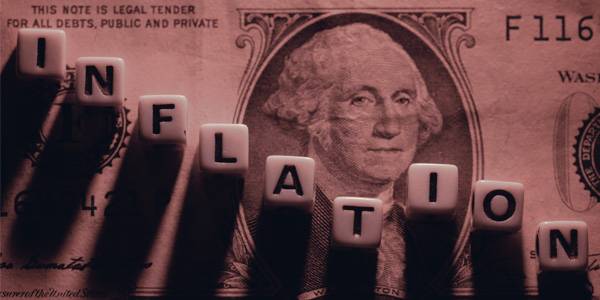Rising inflation has been eating away at the savings that Americans made during the pandemic. Because of this, most people have had to rely on their credit cards, accumulating a lot of credit card debt. As they started to depend on credit cards more and more, they had to increase their credit balances as well. The increased expenses due to the rise in the cost of daily items have led people into financial distress.
Inflation and its effects on the economy
When energy, food, commodities, and other products & services prices rise, the economy suffers. Inflation affects the cost of living, the cost of business operations, taking loans, mortgages, corporate and government bond yields, and all other aspects of the economy.
Inflation can be both advantageous and disadvantageous to economic recovery. Whenever inflation becomes too high, the economy may suffer. On the other hand, when inflation is kept under control and at tolerable levels, the economy may thrive. Keeping inflation in check leads to a rise in employment, and consumers have more money to buy additional products and services, which benefits and grows the economy. But even so, people cannot accurately assess the effect of inflation on economic recovery.
Gross domestic product (GDP), the total value of all finished goods and services produced in a given period, is used to calculate economic growth. The percentage change from the previous year is adjusted for inflation. As a result, if growth is 5% and inflation is 2%, GDP will be reported at 3%.
The dollar's value falls as the cost of essential goods and services rises, eroding its purchasing power.
Why has the use of credit cards increased in the past few months?
During the pandemic, many Americans could pay off their debt with the help of government stimulus checks and fewer chances for non-essential expenditures. Credit card balances are creeping back up because of the rise in gas prices, groceries, housing, and other utilities. The total credit card debt is on the way to surpassing the numbers before the pandemic.
People are using credit cards to try to keep their spending levels the same as they were before the inflationary period began. In light of the current student debt crisis, this is a looming disaster. If and when loan payments resume, many borrowers will find themselves with more debt than they can handle, leading some to turn to credit cards for help.
As inflation soars to its highest level in over four decades, the Federal Reserve has committed to raising interest rates to control it. There is a direct correlation between the Fed's benchmark interest rate and the variable rate on most credit cards. The prime rate and credit card rates rise in tandem with the federal funds rate. Within a billing cycle or two, cardholders begin to notice the impact. As a result, anyone who has a credit card balance will soon be forced to pay even more interest charges.
According to Experian, the average credit card balance is $5,525, and the average annual percentage rate is about 16.38%. This is a low rate compared to the past, but it is much higher than almost every other consumer loan. With more rate increases on the way, credit card rates could reach 18.5% by the end of the year, which would be another all-time high. As a result, the average credit card balance would increase, adding more to the already high-interest rates.
"Another major factor is the ongoing crisis in Europe, the war in Ukraine. This has led to the temporary stoppage of exportation/importation from/to Ukraine of supplies of important commodities," says Matt Post, co-founder of Attorney Marketing Solutions. "Also, the imposition of sanctions against Russia drew setbacks on the sanctioning countries, shooting up gas prices, which would always affect the prices of other equally important commodities, especially food."
What can Americans do to manage the effects of inflation?
To put it bluntly, there isn't much we can do about inflation. Even though our currency is depreciating against the cost of living, People can better manage their finances by keeping cash reserves and ensuring that they can meet any near-term cash flow requirements. You may also want to invest in companies with strong positive free cash flow and excellent balance sheets. The rising cost of living because of inflation has led many people into financial crises. Money problems can be nerve-wracking in a time like this and can sometimes lead to mental health issues.
A recent survey from Bankrate found that more than 40% of adults in the U.S. said that worrying about money hurts their mental health. Most people who said that money was a problem said it made them feel stressed, anxious and overwhelmed.
The primary concern is how people will manage inflation when their income doesn't increase. The main idea here is to focus on the parts that you can control. Inflation is an uncontrollable aspect, and there is nothing that you can do to stop it; it will continue to happen.
What financial decisions should be made in this situation?
It is difficult to manage finances because of inflation. You should remember that inflation never ends, but it does level off. Adjusting to higher prices and planning for financial growth is the best way to move forward.
Here are a few ways that can help you manage your money:
Budgeting
Having a budget or adjusting your budget to accommodate the higher prices caused by inflation is a must. Most consumers don't even think of having a budget, but they should make room for one. Having a budget is critical in times of inflation.
The easiest way to build one is to go back to the basics. To begin, make a list of all of your essential requirements. These items include housing, utilities, food, medication, health insurance, and any debt payments if you have them. Then you make a list of other items that you pay for on a daily basis, like coffee from Starbucks, gym memberships, takeout food, hobbies, and the things you like. The next step is to compare your total income and your total expenditure. You start your budget from there, making changes that suit your needs but also help you save and pay your obligations.
As long as you have money left over after paying for necessities, you should save the rest for at least six months in an emergency fund. If an emergency arises, you must be able to cover the cost.
Cut off unnecessary spending
When your total spending exceeds your income, it's time to make changes. You must look for the things you can do without and cut them off from your budget. This way, you can save money and add it to your savings or obligations.
If you still can't figure out your non-essential expenses, you can ask yourself, before buying an item, "Do I really need this?" "How is this thing going to help me?" By answering these questions, you can easily differentiate between the items you need and those you don't need but want.
Tracking expenditures
When sticking to a budget, you must keep track of your spending. By tracking your expenditures, you will know where your money is going and how much you are spending. You can make cuts or additions as it suits your budget.
Different methods to pay off debt
Due to the increase in the use of credit cards, most consumers will incur debt. When you're struggling to make ends meet, paying the credit card bill goes to the bottom of the list.
Snowball
Simply put, the "snowball method" entails paying off the smallest of all debts as soon as possible. The money you put toward that payment is transferred to the next smallest debt. This procedure should be carried on indefinitely until all accounts have been settled. As you move up the list from the lowest to the highest, the amount of money, you've used "snowballs" to accelerate the pace of paying down your debt.
Adem Selita, CEO & Co-founder of The Debt Relief Company, recommends the snowball method. He says, "I wholeheartedly believe that the debt snowball is the most effective method for paying down debt in this type of environment. " He advises, "It is much easier to tackle than the debt avalanche method and helps simplify your finances."
Avalanche
Using the "avalanche method," you pay off your highest-interest debt first. After paying off your highest interest debt, you'll move on to the next highest interest debt until you've paid off all of your debts. Long-term savings can be had by prioritizing high-interest loans.
The "avalanche method" can save you money, but if you have a large amount of debt, the time it will take to pay off the highest interest debt may discourage you and make it challenging to stick to the plan. It can be rewarding to pay off small debts quickly. Debt management goals may benefit from using the "snowball method," which allows you to see progress quickly and work your way up.
Snowflake
The debt snowflake method is similar to the avalanche and snowball method but slightly different. It focuses on the small amounts of money you can save and add to your monthly debt payments, and it's more about getting the money together and being smart about how you spend it.
Debt Consolidation
Debt consolidation is your friend when you have too many debts and don't know how to handle them. One way to use debt consolidation to lower your total debt is to get a new loan to pay off your old debts. Consolidating debt into one personal loan can result in lower interest rates and monthly payments, making it easier to pay off the loan. Consolidating credit card debt, student loan debt, payday loan debt, and mortgage payments are all viable options.
You can do debt consolidation through:
- Balance transfer card
- Debt consolidation loans
- Debt consolidation programs
Debt management
If you are struggling to keep up with your debt payments, a debt management plan may be able to help. The purpose of a debt management plan is to help you lower your interest rate and monthly payment while also assisting you in developing a budget that can accommodate the payments you must make. Non-profit and for-profit credit counselors offer debt management plans, and credit counselors negotiate lower interest rates with creditors to lower your monthly payments. One of the most common debt-reduction strategies is consolidating your debts into one low-interest loan, like a mortgage.









